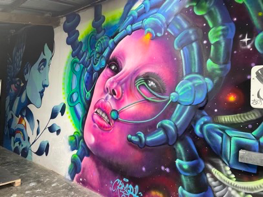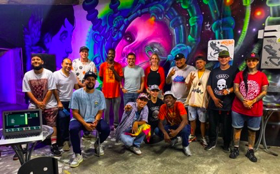Purple. Green. Blue. Gray. Different shades of purple combined with yet more shades of green, blue, gray. Colors that meet and coalesce producing more, yet nameless, colors. Transitions. Graffiti murals depict transitions from one color to another, from one form to another. Transitions and meeting points too: intersections. A graffiti mural is an intersection made of metaphors… metaphors indeed: graspable, comprehensive, images. Such is the case of the graffiti mural that welcomes friends and visitors at Casa Kolacho, an artistic youth collective in Comuna 13 in Medellin, that builds spaces of peace and peaceful coexistence in the middle of social conflicts. As we are welcomed, they tell us that “this mural represents a constant transition, the necessary oscillation between nature and culture”. It depicts two female faces. One, on the left, completely embraced by nature. And the other, on the right, surrounded by technology, or the product of “culture”.

We have worked with Casa Kolacho for some years, and this time we are visiting to catch up on our work after two years of physical absence, of course because of the COVID 19 pandemic. We are also there to conduct one of a series of workshops that will give us the data to co-create Casa Kolacho’s Theory of Change, a set of indicators to measure the effects of their work, and some of the elements we need to support them in the design of their own peacebuilding methodology. Right from the start, as we begin to tease out the method of work of this youth organization, we notice that their work is in conversation with the Environment, Social, and Governance (ESG) standards that companies and organizations around the world are striving to implement in their work. They are concerned with climate change and implemented solar panels for the functioning of their house, and are raising awareness about pollution, the effects of greenhouse gas emissions, and the need for humans to establish a different relationship with the natural environment. The nature of their work is social, in that they have found effective ways to do peacebuilding using art and education. Recently, they have become aware of the importance of including diverse voices and ways of thinking in their internal governance, taking a race and gender perspective in most of what they do.

In a participatory way, Casa Kolacho is developing a methodology that captures their work with the community, which includes, artistic formation for children and youth, building leadership skills, social entrepreneurship capacities, and conflict resolution and peacebuilding abilities, among other things. This methodology is called ParchArte, from the colloquial expression “parchar”, or to hang out, and “arte”, or art. This expression alludes to a territory, a place, where diversity is celebrated, that is creative and fun, and where social and environmental transformations are being crafted and executed. It also insinuates an invitation. If you are told to “parcharte” by a youth leader in Medellin, you are being invited to be at ease, to have fun, to express your creativity, and above all, to contribute to their incessant work towards social transformation.
ParchArte will be a methodology that encompasses effective methods for social transformation drawing from years of effective community work—organic knowledge, if you will— as well as proven academic and practice-oriented methods, such as the Coordinated Management of Meaning (CMM) and ESG standards. Like the mural at the center of Casa Kolacho, ParchArte is a metaphor that captures at the same time an intersection, a transition, and a social transformation in the making.
